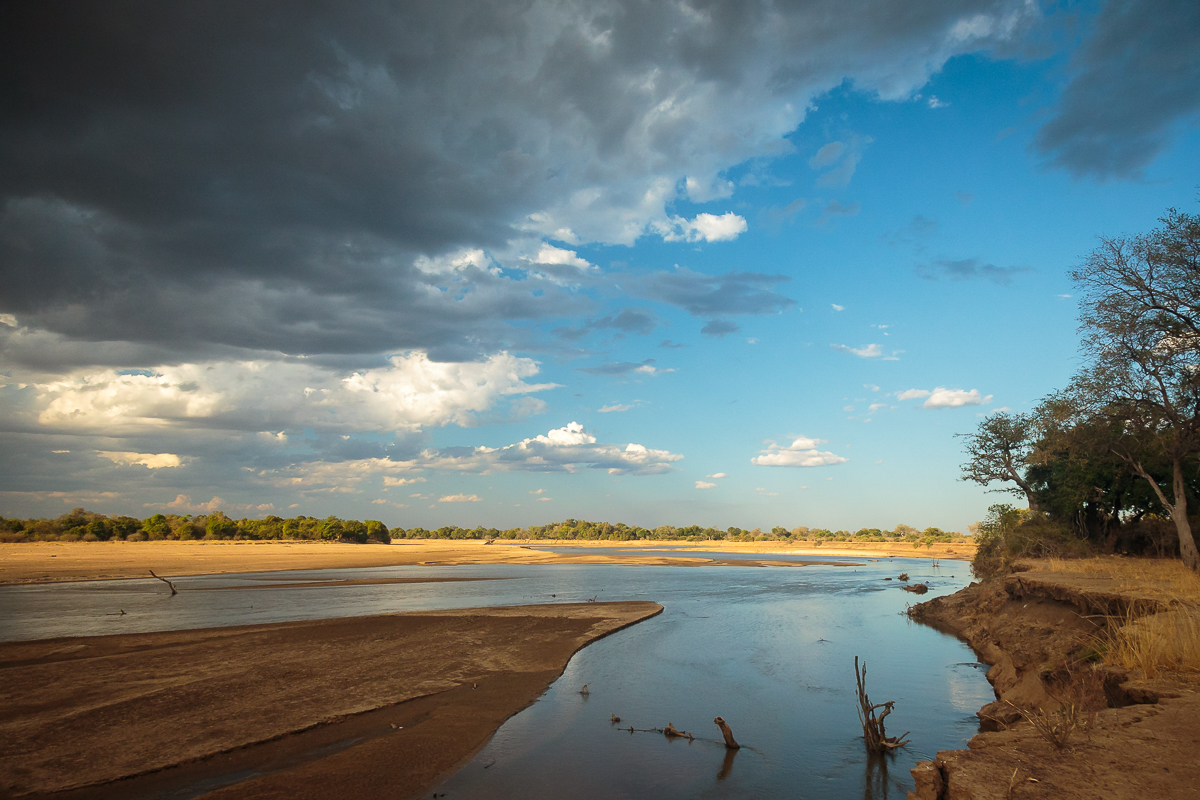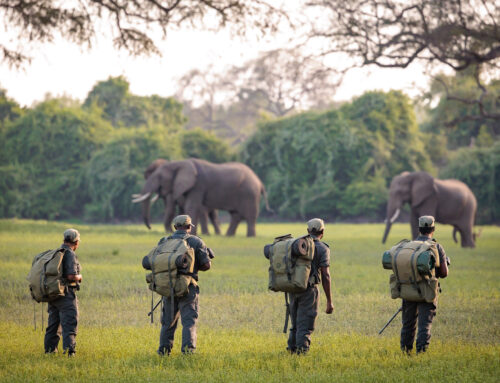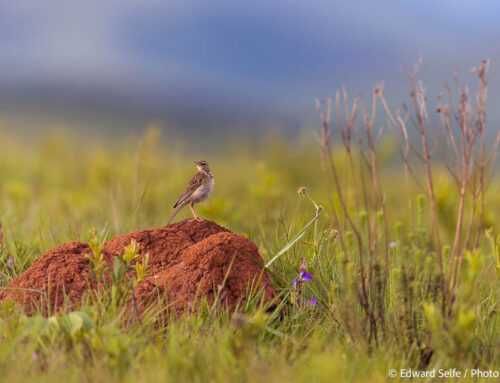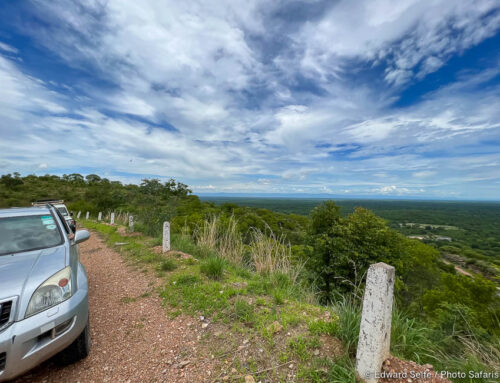Since the 1980s there has been talk of building a dam in the lower course of the Luangwa River to generate electricity. Each time it has been raised, the idea has been shelved, presumably on the basis that the cost-benefit analysis did not hold up to scrutiny. When the so-called Ndevu Gorge Dam project was raised again in 2016, it was assumed that discussions would end in the same conclusion.
However, this time around the project has been formalised and engineering companies across the SADC region have been tendering for the construction. The specifications of the dam project suggest that there would be a dam wall 80m in height and 427m across blocking the river as it enters the neck of a narrow gorge. There would also need to be a secondary dam wall to prevent the resulting lake from spilling over at another point; this secondary dam would be 17m high and 1,602m long. The lake created would be 165km long and 17km wide in places; it would contain a staggering 47 cubic km of water, and cost an equally staggering US $1.26bn.
Dams to generate electricity have been installed in river systems across the world. They generate valuable electricity but they also damage fragile freshwater ecosystems and the terrestrial environments along their banks. By fragmenting them into sections, large dams heavily disrupt river systems causing reductions in species density and diversity. In fact, such is the importance of free-flowing rivers that the World Wildlife Fund has designated a project for their protection. Their project research suggests that there are more than 60,000 major dams across rivers globally and therefore the value of intact river systems to Nature, science and people cannot be overstated.
It is for this reason that the proposed Ndevu Gorge dam is significant; the Luangwa is Africa’s longest un-dammed river and the life-blood of two of the world’s finest wildlife ecosystems, the North and South Luangwa National Parks (NLNP & SLNP). Damming this river will generate power for the Zambian population’s growing demand for electricity, but it will also have damaging and far-reaching impacts on the wider ecosystem of Eastern Zambia. An unofficial Environmental Impact Assessment conducted by the Watershed Institute suggests that the project may “irreversibly alter the free-flowing Luangwa River”.
Those who know and value the Luangwa for its extraordinary wildlife wonder how such a project can possibly be approved. However, there are many factors to consider and it can only be hoped that he decision whether or not to sanction such a project will assess the benefits of increased power generation against the cost of the project and the costs to other sectors of the economy and the wider environment.
The proposed Ndevu Gorge dam will cost an estimated US $1.26bn, though this figure may be adjusted as the parameters of the project are defined. The turbines will generate up to 235MW of electricity which is considerable in Zambia’s efforts to make up a peak-demand shortfall of 600MW. Also in the project’s favour is the improved infrastructure that would be needed to support the build and the employment opportunities generated in an area where there is currently little economic activity.
What is not considered in any of the news reports is an assessment of the impacts that this dam will have on existing economic activity in the surrounding areas. As is often the case, a lack of apparent business activity leads law-makers to assume that they can proceed without meeting opposition from stake-holders. In fact, it is exactly the lack of agriculture, human population, infrastructure development and supporting services that has allowed the Luangwa River valley to persist as one of Nature’s finest wildlife zones.
This valley system is home to large, concentrated populations of iconic big-game species, a wide range of smaller mammals and more than half of Zambia’s bird species. Economic activity is overwhelmingly tourism along with agriculture and forestry. The land is sparsely used, with much of it still in untouched form and either under the jurisdiction of the Department for National Parks and Wildlife or traditional chiefs. The estimated impacts of such a dam are staggering. Even though the dam is roughly 100kms south-east of the SLNP, the resulting lake will still stretch 65km inside the National Park’s boundaries. Nearly 30% of the river’s length inside the National Park will be converted from river to lake. Some 250 sq km or 3% of the SLNP’s surface area will be destroyed.
Added to this, the areas between the south-eastern boundary of the SLNP and the dam are also important for wildlife. These are Game Management Areas (GMAs) where hunting is permitted under licence, and they form crucial buffer zones between human encroachment and the protected National Parks. These areas will be heavily affected by the creation of the dam’s lake; some GMAs will lose as much as 11% of their surface area, with individual ranches losing between 12 and 81% of their operating areas. Of course, the areas that remain will be the more marginal zones, on higher slopes and further from the river.
Damming a river also has significant implications for flow and the natural processes of the waterway. The soft alluvial soil of the river valley is easily eroded and transported in the flow. This allows for relatively fast changes in the shape and course of the river, leaving a continuous supply of newly-formed ox-bow lagoons and seasonal pans. These habitats are characteristic of the area and crucial to the wildlife of the area. Flooding large areas reduces availability of these habitats to wildlife, and impeding the flow affects the natural creation of the same.
Upstream of the highest point of the reservoir, the dam will cause backwater effects. In the case of the Ndevu Gorge dam, it is estimated that the backwater zone will encompass the confluences of the Lusingazi and Kapamba Rivers with the main Luangwa channel. Given the complexity of this 3 river convergence just above the terminus of the dam’s lake, it hard to estimate the impacts precisely. But comparing with similar rivers elsewhere, it is likely that water levels will be higher than normal, with longer flooding periods, greater sediment deposition and changes in the flow and shape of the river around these two confluences. This will heavily impact tourism operators in these areas, affecting their operating seasons and income generating capacity.
Changing river morphology may not always be negative per se. However, in the case of the Luangwa, there is significant aesthetic and wildlife value in preserving a major river system in its unaltered state. There is also a thriving wildlife tourism industry throughout the SLNP, and economically important trophy-hunting business in the surrounding areas. Not only are these industries worth upwards of US $30m per annum, they are also important custodians of the wildlife areas, providing presence, anti-poaching and financial support for maintain their respective areas in pristine condition.
The dam may impact the viability of wildlife- and safari-tourism in the area, threatening the future of these industries and also thousands of jobs; in 2015, safari operators in the SLNP provided employment for around 1,100 people, supporting 5,500 family members and indirectly another 350 in secondary services. The overall income in wages for local people in the immediate area was more than US $3.5m. Damaging this industry would have significant effects for local livelihoods in the Luangwa Valley.
The Luangwa ecosystem is home to some globally important populations of certain species which would be negatively affected by changes in the natural riverine system; African wild dogs (classified as Endangered on the IUCN Red list) roam widely across the valley and would be impacted by habitat loss and changes in land use. As well as being a highly threatened species, wild dogs are also economically important to the tourism industry.
Other threatened species such as Grey Crowned Cranes and African Elephants are found in strong numbers in the Luangwa, but changing land cover patterns and particularly water coverage will heavily affect both these species, limiting feeding opportunities for both and nesting sites for the former. Elephants are particularly affected by changes in water ways since they roam so widely and use channels as navigational routes. With the continent’s elephant numbers in decline, care must be taken to protect important sub-populations such as the Luangwa’s.
The Luangwa is also the only place where Thornicroft’s giraffe are found. They are known to live along the river, preferring riverine habitats especially in the dry season. Changes to the width and depth of the river would prevent their normal movements across the river, especially where the lake has inundated the river and where backwater effects deepen the channel.
Hippos are a major feature of the Luangwa ecosystem, not only visually but also as a crucial component part of the healthy river system; their dung fertilises water-ways and their movements keep channels from silting up. Changes in the meandering river system would reduce the number of important river bends which offer hippos entry- and exit-points from the river, deep and shallow water and safe beaches for sun basking.
In short, adjustments to the river in any way, given its role as life-blood for the whole Luangwa system, would have dramatic impacts on many of the iconic and important species that make the Luangwa what it is. There is not scope in this article to consider the effects on smaller organisms, but it’s safe to assume that changing the river from its optimal state will not be beneficial for any wildlife.
The dam proposal documents also cite benefits to Zambia in terms of greater diversity of economic activity associated with the lake. These include fishing, boating, increased agriculture (downstream of the dam through enhanced irrigation) and associated benefits from the investment in infrastructure required to support these. While these effects cannot be refuted, the damage to wildlife real-estate from the proliferation of these developments must be considered.
Road infrastructure running across the valley, along the lake and to the river would facilitate improved services in these areas but would increase extraction of natural resources. Timber, rock, sand and animal products would all face more human pressure when communication networks enable easier extraction. Illegal activities such as poaching (most likely in the form of snaring) and illegal felling of protected tree species would follow, and the negative effect on wildlife would be increased further.
Detractors might argue that the areas most affected are sub-prime wildlife zones, and it’s true that this is supported in evidence. But these areas act as wildlife corridors, allowing populations to mix with other populations. The lower Luangwa Valley – while not a rich as the central and upper sections – forms a link with the Lower Zambezi National Park allowing individuals from each area to cross over and maintain genetic diversity. Building roads that cross the Valley, encouraging human settlement, and creating a large lake all narrow these wildlife corridors and isolate populations of species from others. It has been shown that individual wild dogs have travelled through 3 of the 4 National Parks in the Luangwa Valley, and it likely only because there is not a research project focused on them that we have not discovered the same about other species too.
The Ndevu Gorge HEP project makes sense as an energy-generating and area-development project. It will increase Zambia’s electricity-generating capacity and provide a flow of investment into an area where there is currently little economic activity. However, none of the proposals circulated so far take into account the globally-important wildlife area that exists only 100km upstream of the site. Not only will the resulting lake affect the river flow through one of the world’s finest National Parks, it will also encroach on the area of that park by inundating the river for 65kms of its length. This will erode habitat for wildlife, reduce animals’ migratory passages and have unpredictable impacts on the hydrology of the river. For the wildlife and the wildlife-tourism industry in the Luangwa, the Ndevu Gorge project would be a disaster; the world would lose one of the last natural and unspoiled river systems in order to produce an extra 10% of one nation’s electricity requirement. This 10% may be significant now, but increasing energy needs as Zambia develops over the coming years will dwarf this contribution. Add to this the secondary impacts caused by the infrastructure associated with the dam, and it’s not an overstatement to say that the project would cause irreparable damage to the Luangwa ecosystem.
The final factor to be considered is that Zambia is also considering an HEP project in the Batoka Gorge. While that area will have its own reasons for not wanting a dam, the Zambezi river is alredy dammed twice and has lost its valuable status as a pristine river. This Batoka Gorge dam will generate over 2,400MW of power, more than 10 times that of Ndevu Gorge. Surely it makes no sense to cause such damage to the Luangwa ecosystem when a project that will generate 10 times the power is already in the pipeline?
————————
Reference: CSUMB Class ENVS 660: Conlen A, Eichorn E, Greenway S, Hutton T, Inglis N, Morris M, Robinson M, Watson F. 2017. Proposed Ndevu Gorge Power Project: An Overview of Biological and Conservation Impacts on the Luangwa River Valley. Watershed Institute, California State University Monterey Bay, Publication No. WI-2017-04




